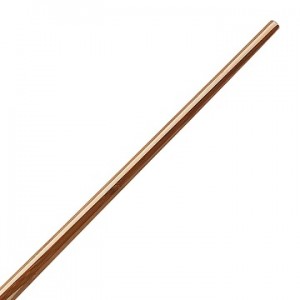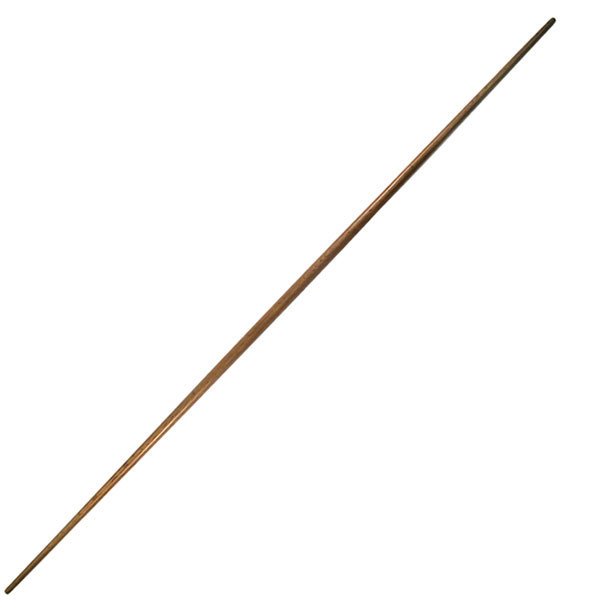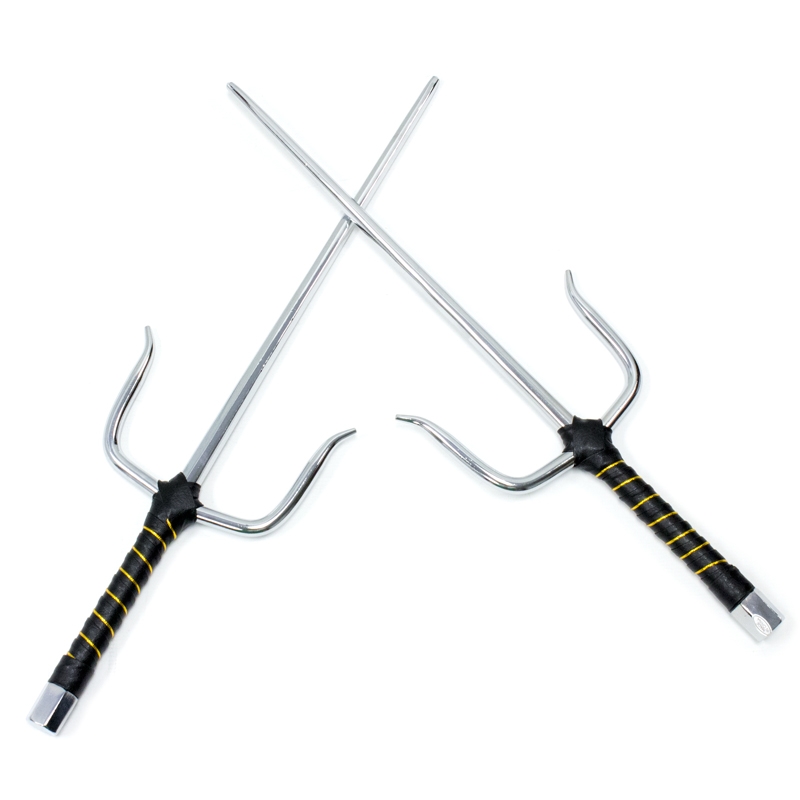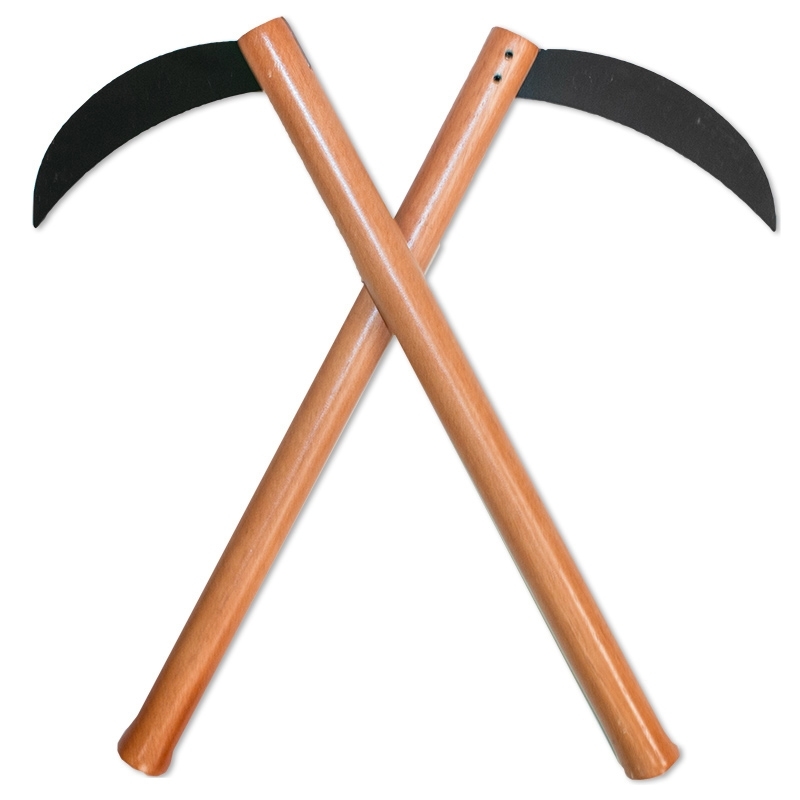Weapons

Bo/Kon
The Rokushaku Bo, Roku means six, shaku is a measure of about 1 foot in length. Hence the Bo is about 6 foot. This weapon is the most commonly used weapon in Okinawan Kobudo systems. The Bo tapers from the centre of about 1½” to each end of approximately ¾”. It is made of a hard wood, generally red oak. The taper maintains the fulcrum of the Bo at the centre, keeping it balanced and easier to handle. It also provides more tensile strength, making it more flexible and lass prone to breakage. This taper also facilitates powerful whipping of the Bo during striking and blocking.

Hasshaku Bo
The Hasshaku Bo is approximately 8 feet of length. Training this weapon develops tremendous forearm and wrist strength.

Jo
The Jo is a cane of approximately 1.20 m of length. According to a very spread legend, at the beginning of the 17th century Muso Gonnosuke Katsuyoshi created the Jo after his defeat in a singular combat with the famous Miyamoto Musashi. Katsuyoshi was fighting with a Bo against both Musashi’s katanas. Recognizing the advantage of handling a shorter weapon, Katsuyoshi fought once again later against Musashi and won by means of the use of the new short cane.

Sai
The Sai is thought to have been introduced to Okinawa through trade with one of the Asian countries. It did not become popular in Japan, but developed primarily in Kobudo styles of Okinawa. The Sai was thought to be used by the police, Chichi saji of the Ryukyu Kingdom. The Chinese character (kanji) for Sai means “hair pick”, thus creating conjecture that the Sai was either designed after a hair pick or named after one because of its similar appearance. Other theories of origin are that it was fashioned after the shape of the human form, hence a policeman’s badge of office. Also after a religious symbol “Manji”, which can be seen on church roofs.

Manji Sai
The Manji Sai is similar to the Sai; the main difference between the Manji Sai and the regular Sai resides in the tsuka (handle) and the opposite direction of one of the tsuba (prong) of the Manji Sai. The common way to carry this weapon is in a set of two, primarily hidden in the belt or sash. Because of this similarity of Manji Sai with the regular Sai, it allows the person carrying this weapon to use it as a Sai, this means to attack or defend, or to be thrown at an opponent. The Manji Sai is used in conjunction with Nunti Bo. It has been actively practiced in Okinawa as a martial art for a long time. This technique was handed down to the late Shinko Matayoshi Sensei by Kingai Sensei in Shangai, China.

Nunchaku
The Nunchaku is formed basically by two very short sticks 3 to 6 dm long, joined at their ends by a rope or chain. There are three very recognized hypotheses about the cause of the invention of the Nunchaku. The first one says that they were used by the women to colect the highest fruits of the trees, throwing them up in order to break the union between the stem and the fruit. The second one says that they were used as bridle for the horses and finally it is also said that it was used to peel the rice, to separate the grain from the straw.

Nicho Gama/Kama
The Kama is a bladed weapon and is indigenous to many farming countries of Asia. It is a sickle used in harvesting. Long and medium versions were used to cut fruit from papaya trees. The short version was used to harvest rice and cut grain. Although Kama practitioners in Kobudo use them in pairs, they were used individually for farming, with a spare kept in the belt in case of breakage. In the time when metal was scarce, the Kama has been know to be made from seashells for the cutting edge. The handle is made of hardwood that is larger at the end to aid gripping. A curved blade, sharpened on the inside, extends from one end.

Tunkuwa/Tonfa
The word Tunkuwa means, “handle” and has three theories as to its origin: 1-Most common is the handle, wedged into a hole in the side of a large milling stone, for grinding rice and grain (see opposite). 2-A hook for hanging pots over a fire or a table. 3-A type of short hoe in which the handle was used to dig. Tunkuwas, usually made of red oak, measures around 15’’ to 20’’ in length with a handle at 90 degrees to the main body. Although the configuration of ancient tunkuwa remained constant in shape, the main body has differed in style from square to round, or half round. This weapon is so versatile that the American police and some of the British forces have adopted it.

Eku
The Eku is the Okinawan oar, although it is also used as a tiller, not only propelling a small boat but controlling the course as well. The reason for its shape, in comparison to the western oar, is mainly due to its ability to cut through the strong currents around Okinawan coastline. The Okinawan fishermen, after tying up their boats on the beach, used to take the Eku with them, both for self-defense and to discourage the theft of their boats.

Nuntibo
The Nuntibo is a Bo which is attached to a Manji Sai at the end. Thus providing a weapon that has all the elements of a Bo but the Manji Sai provides techniques that are similar to a spear and the two hooks in opposing directions gives the practitioner the ability to hook and trap. The weapon was most likely brought back to Okinawa about 600 years ago, when the Okinawans used to travel and trade with China. Matayoshi Shinko was taught this weapon by Master Kingai in Shanghai China, and according to him the Nunti meant Nuchidi (thrusting hand).

Suruchin
The Suruchin is a weighted rope, whereby a stone is tied to the palm fibre rope. Lengths can vary from 90 cm to 240 cm. It is thought that it was originally used to chase away lions and tigers. The function is to hit as well as to wrap around an attacker to bring them down. It has been practiced in Okinawa for many years and is said to be influenced by the Chinese art of “Muchi” (rod art).

Tinbei
The Tinbei and Seryuto are a shield and short machete weapon combination. It was used in actual warfare in Okinawa and has a long history. The Tinbei (shield) can be made of various materials but is commonly found in vine or cane, metal, or turtle shell. The Seryuto (short machete) is usually equivalent to the length of the forearm.

Kuwa
The Kuwa is the hoe and was the weapon used mostly by farmers. Therefore its background is similar to the Kama as both are agricultural tools with a sharp cutting edge. The Kuwa is used as a defensive and attacking weapon using its cutting edge and its handle. The blade is typically used to kick up mud into the attacker.

Sansetsukon
The Sansetsukon, or three sectional staff, is constructed of three 70 cm sticks chained together, thereby making it longer than a Bo. Its application in the art is to swing the sections around, or as a Bo to defend of the attacker. It has a close similarity to Nunchaku and was developed around the same time in China.

Tekko
The Tekko is a traditional Okinawan (Japan) martial arts weapon. It is a hand-held metal weapon similar to a knuckle buster or brass knuckles. Given that non-Samurai were forbidden to carry weapons in feudal Japan, the Tekko was meant to be concealed and available for self-defense. Originally, they were made from horse shoes and thus not very suspicious.

Chogama
The Chogama is originally a Chinese edged infantry weapon. The blade of the weapon is shaped like a Chinese broadsword, but the weapon has a longer handle, usually around one and a half to two meters (about four to six feet) which is circular in cross section. The Chogama is sometimes called a “horse-cutter sword” since it is speculated to have been used to slice the legs out from under a horse during battle.

Kurumanbo
The Kurumanbo is a versatile weapon which originated in China from the ancient Shaolin temple and Shaolin martial arts. It is a flail-type weapon which consists of a long staff with a shorter rod attached by a chain, to serve as a cudgel.

Tecchu/Ticchu/Tecchyu
The Tecchyu is one of the few hand held weapons which can be concealed, easily carried and used for devastating effects on an opponent (punching, raking, slashing and stabbing). This weapon fits inside a closed fist and extends some what out each side of the fist. From this pole, another pointed pole projects at 90 degrees through the index and middle fingers, providing a striking point which is supported by the fist.
